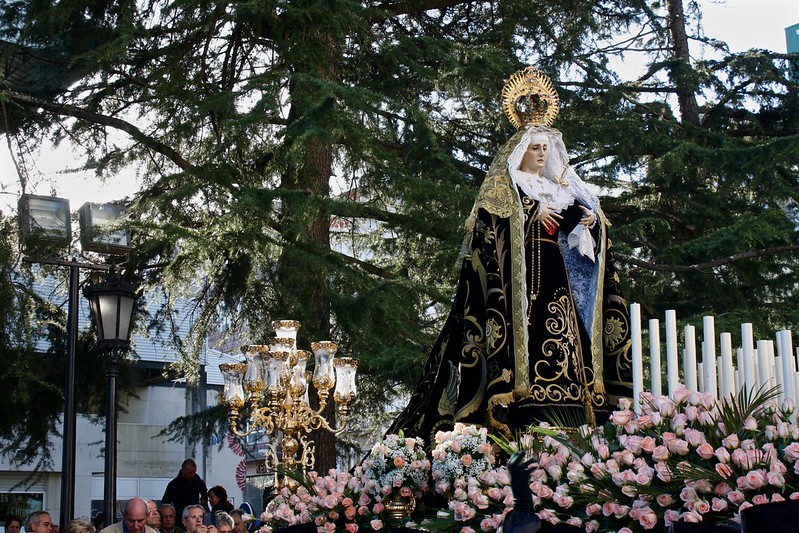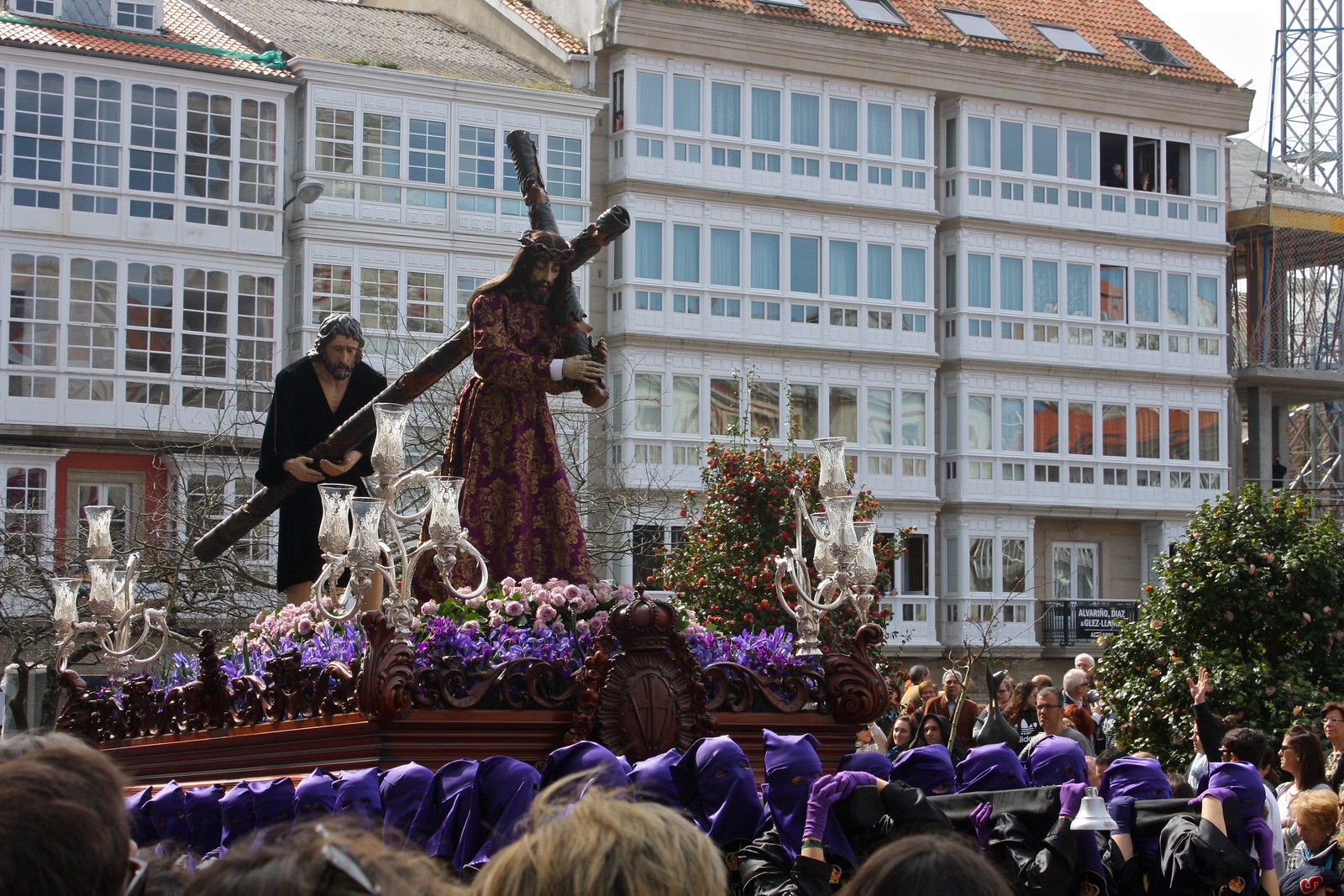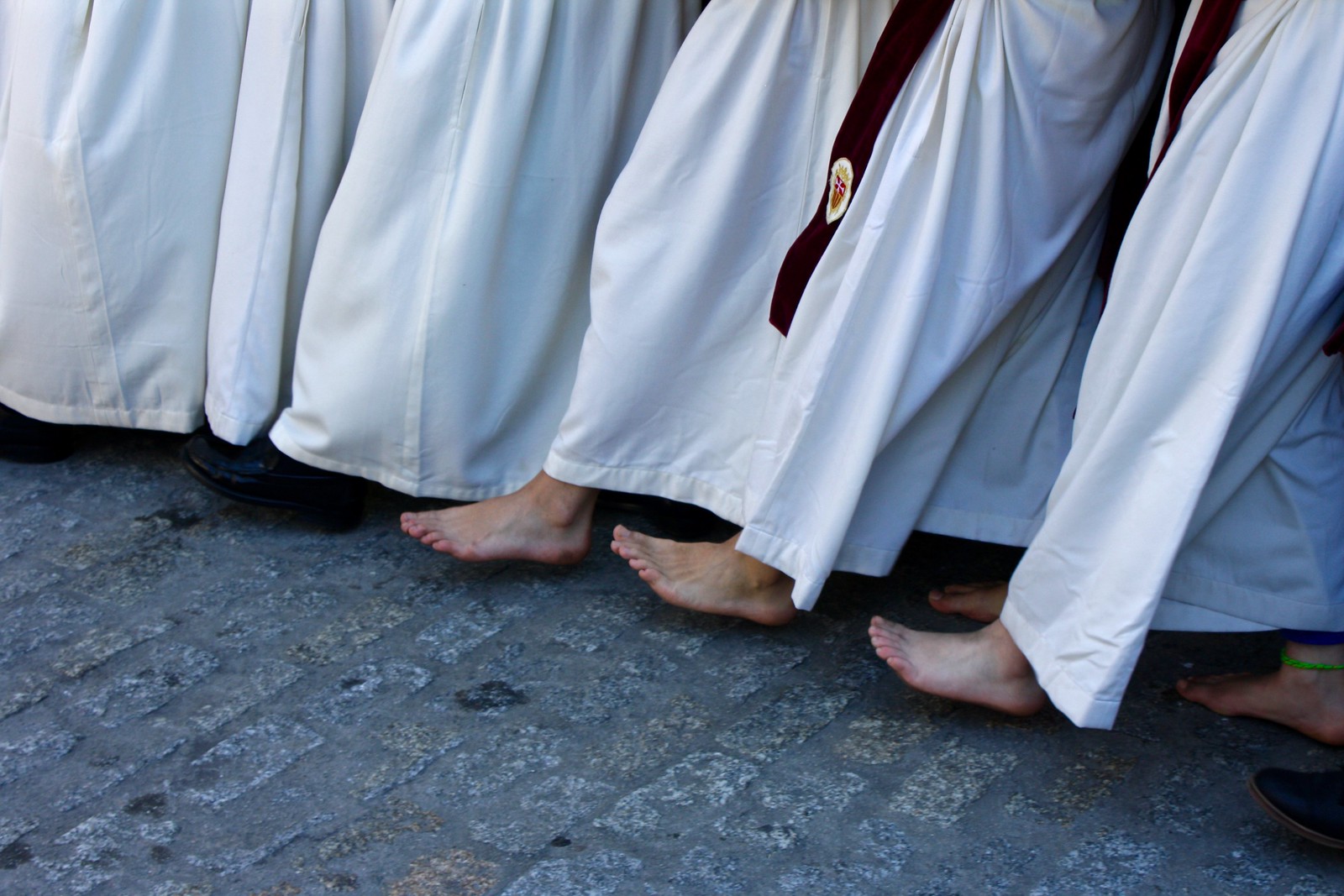Photo Post: Holy Week Processions in Ferrol, Spain
When I lived in Spain and taught English, I always took full advantage of the annual Semana Santa vacation during the week leading up to Easter Sunday to go on a major international trip, since you use up half your time off just getting out of the country and flying back on weekend trips. For my first year, I rode a ferry across the Mediterranean and explored northern Morocco, while in my second school year abroad, I train-hopped from Santiago down into warm, sunny Portugal.
Although in 2015 I still planned on leaving Spain for a brief getaway to Germany, I wanted to be back in the country before Holy Week was over. After all, Spain throws one of its biggest, most unique celebrations for Semana Santa, and I would have regretted not experiencing this fascinating cultural tradition before moving back to Texas.
So I decided to check one off the ol’ bucket list and spend all of Good Friday chasing religious processions in the city of Ferrol on Galicia’s northern coast. Ferrol’s the oddball of northwest Spain for many reasons, not least of which is their enthusiasm for this holiday that seems more in line with their sober neighbors in Castilla or more exuberant compatriots in Andalucía. Galicians don’t really go over the top at all for Easter, so Ferrol is basically the only place you can see quality pasos or processions in the region.
These processions need a little explanation for foreigners. Many Spaniards—be they devout or cultural Catholics—belong to religious brotherhoods called cofradías or hermandades, some of which date back hundreds of years. Although they’re involved in other undertakings, their most visible activities are the religious processions that they put on during Holy Week every year. Members don glossy, colorful robes and transform into anonymous, pointy-hat-wearing nazarenos (“Nazarenes”) or penitentes (“penitents”) whose roles run the gamut from looking somber and carrying candles to blasting trumpets at three in the morning and carrying weighty wooden floats on their backs around town. These floats bear wooden sculptures that portray all the biblical events of Holy Week.
City streets teem with residents who show up for these processions during the eight-day period from Domingo de Ramos (“Palm Sunday”) through Viernes Santo (“Good Friday”) and onto Domingo de Pascua (“Easter Sunday”). Schools take the entire week off so it effectively functions as the Spanish spring break.
I arrived at Ferrol a little later than I had planned on; sleeping in even half an hour later made it a little tricky to transfer to one of the few clunker diesel trains that run between A Coruña and Ferrol. Once I got there I hurried into the old town, backpack thumping against my back as I speed-walked.
It was sensory overload when I entered the crowded Praza de Armas, epicenter for the midday processions: purple-clad nazarenos carried a float that depicted Christ carrying the cross to Calvary. Some of their brothers played loud, mournful trumpet tunes, while others slipped pieces of candy to kids watching the procession. Warm rays of spring sunshine vied with chilly ocean breezes that lingered in the shadows. And little old ladies’ heavy perfume mixed with the occasional hint of lilies, roses, or even orange blossom.
In true blogger form, I took a bajillion photos and pushed and shoved to swim over to the other side of the square to get a look at one of three processions that was finishing there. I honestly felt a little underdressed, since most folks were in their Sunday best yet here I was, the foreigner, in shorts and a hoodie.
After taking advantage of the low cost of living in Ferrol and “splurging” on an all-inclusive menú del día lunch for 8,50€, something changed in this Must-Document-Everything blogger’s heart. I camped out in the cathedral churchyard, trying to figure out where to best photograph the Procesión del Traslado from—a tall order, since I had to deal with head-on sun and peoples’ heads getting in the way. I managed to snap some real stunners of this float that had a truly regal Virgin Mary surrounded by hundreds of pink roses and precarious, tall white candles. The nazarenos “parked” the float directly in front of the cathedral’s main west doors to await the second stage of the procession.
Standing just to the side of the doors, I watched as the ladies of the church solemnly walked out dressed in all black and sporting tall combs draped with lace mantillas. Musically-minded nazarenos blared a brassy dirge, while others marked the beat with silver staffs and oozing candles. The heady aroma of burning incense overwhelmed me momentarily, but my attention quickly fixated on the Instruments of the Passion, a metal Crown of Thorns and three shiny nails, carried respectfully on black pillows. Finally, pallbearers came out of the cathedral with a glass box, inside of which lay a sculpture of Cristo Yacente, the dead or “lying down” body of Christ. Across the churchyard, the Virgin Mary wept for her son.
And then it hit me what these over-the-top productions during Semana Santa are all about.
This centuries-old tradition is a dramatic re-enactment of the events surrounding the Passion of the Christ. In an age where most faithful were largely illiterate, these religious processions would have served a similar function that stained glass did in Gothic cathedrals. What I had just observed in the churchyard was the reenactment of Christ’s funeral, a ritual re-telling of this chapter of the Easter story.
I ended Good Friday by observing the Os Caladiños midnight vigil (“the little quite ones”), a silent, somber procession that returned to the cathedral under the light of an appropriately-spooky full moon.
What was your favorite photo from this post? How have you come to terms or gained a deeper understanding of a foreign culture? Share your thoughts below in the comments section!

 |
| Procesión de Jesús Nazareno (Cofradía de Dolores) |
Although in 2015 I still planned on leaving Spain for a brief getaway to Germany, I wanted to be back in the country before Holy Week was over. After all, Spain throws one of its biggest, most unique celebrations for Semana Santa, and I would have regretted not experiencing this fascinating cultural tradition before moving back to Texas.
So I decided to check one off the ol’ bucket list and spend all of Good Friday chasing religious processions in the city of Ferrol on Galicia’s northern coast. Ferrol’s the oddball of northwest Spain for many reasons, not least of which is their enthusiasm for this holiday that seems more in line with their sober neighbors in Castilla or more exuberant compatriots in Andalucía. Galicians don’t really go over the top at all for Easter, so Ferrol is basically the only place you can see quality pasos or processions in the region.
 |
| Procesión del Crucificado (Cofradía de la Merced) |
These processions need a little explanation for foreigners. Many Spaniards—be they devout or cultural Catholics—belong to religious brotherhoods called cofradías or hermandades, some of which date back hundreds of years. Although they’re involved in other undertakings, their most visible activities are the religious processions that they put on during Holy Week every year. Members don glossy, colorful robes and transform into anonymous, pointy-hat-wearing nazarenos (“Nazarenes”) or penitentes (“penitents”) whose roles run the gamut from looking somber and carrying candles to blasting trumpets at three in the morning and carrying weighty wooden floats on their backs around town. These floats bear wooden sculptures that portray all the biblical events of Holy Week.
City streets teem with residents who show up for these processions during the eight-day period from Domingo de Ramos (“Palm Sunday”) through Viernes Santo (“Good Friday”) and onto Domingo de Pascua (“Easter Sunday”). Schools take the entire week off so it effectively functions as the Spanish spring break.
 |
| Procesión del Traslado (Cofradía de Dolores) |
I arrived at Ferrol a little later than I had planned on; sleeping in even half an hour later made it a little tricky to transfer to one of the few clunker diesel trains that run between A Coruña and Ferrol. Once I got there I hurried into the old town, backpack thumping against my back as I speed-walked.
It was sensory overload when I entered the crowded Praza de Armas, epicenter for the midday processions: purple-clad nazarenos carried a float that depicted Christ carrying the cross to Calvary. Some of their brothers played loud, mournful trumpet tunes, while others slipped pieces of candy to kids watching the procession. Warm rays of spring sunshine vied with chilly ocean breezes that lingered in the shadows. And little old ladies’ heavy perfume mixed with the occasional hint of lilies, roses, or even orange blossom.
 |
| Procesión del Traslado (Cofradía de Dolores) |
In true blogger form, I took a bajillion photos and pushed and shoved to swim over to the other side of the square to get a look at one of three processions that was finishing there. I honestly felt a little underdressed, since most folks were in their Sunday best yet here I was, the foreigner, in shorts and a hoodie.
After taking advantage of the low cost of living in Ferrol and “splurging” on an all-inclusive menú del día lunch for 8,50€, something changed in this Must-Document-Everything blogger’s heart. I camped out in the cathedral churchyard, trying to figure out where to best photograph the Procesión del Traslado from—a tall order, since I had to deal with head-on sun and peoples’ heads getting in the way. I managed to snap some real stunners of this float that had a truly regal Virgin Mary surrounded by hundreds of pink roses and precarious, tall white candles. The nazarenos “parked” the float directly in front of the cathedral’s main west doors to await the second stage of the procession.
 |
| Cristo Yacente |
Standing just to the side of the doors, I watched as the ladies of the church solemnly walked out dressed in all black and sporting tall combs draped with lace mantillas. Musically-minded nazarenos blared a brassy dirge, while others marked the beat with silver staffs and oozing candles. The heady aroma of burning incense overwhelmed me momentarily, but my attention quickly fixated on the Instruments of the Passion, a metal Crown of Thorns and three shiny nails, carried respectfully on black pillows. Finally, pallbearers came out of the cathedral with a glass box, inside of which lay a sculpture of Cristo Yacente, the dead or “lying down” body of Christ. Across the churchyard, the Virgin Mary wept for her son.
And then it hit me what these over-the-top productions during Semana Santa are all about.
This centuries-old tradition is a dramatic re-enactment of the events surrounding the Passion of the Christ. In an age where most faithful were largely illiterate, these religious processions would have served a similar function that stained glass did in Gothic cathedrals. What I had just observed in the churchyard was the reenactment of Christ’s funeral, a ritual re-telling of this chapter of the Easter story.
 |
| Procesión de Os Caladiños (Cofradía de Dolores) |
I ended Good Friday by observing the Os Caladiños midnight vigil (“the little quite ones”), a silent, somber procession that returned to the cathedral under the light of an appropriately-spooky full moon.
What was your favorite photo from this post? How have you come to terms or gained a deeper understanding of a foreign culture? Share your thoughts below in the comments section!
